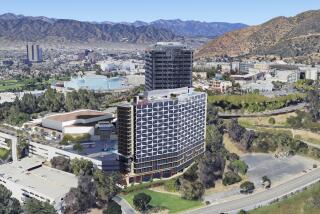Price tag for schools complex at former Ambassador Hotel site now tops $578 million
- Share via
The price tag for a complex of schools at the site of the famed Ambassador Hotel has become the Los Angeles Unified School District’s most expensive school project, now surpassing $578 million.
The latest cost increase, approved Tuesday by the Board of Education, adds $6.6 million for expenses related mostly to safety and historic preservation at the complex for 4,200 students.
The main campus of the Robert F. Kennedy Community Schools will open this fall. Two small schools already operate on the back portion of the 24-acre Koreatown site.
The school district first set its sights on the faded Ambassador, once a playground of stars and world leaders, in the 1980s to address severe school overcrowding. Officials battled over the Wilshire Boulevard property with developer Donald Trump, who wanted to erect the world’s tallest building.
Competing legal claims stalled all development, leaving the closed hulk of the hotel in place for years. After the district finally gained control, it battled historic preservationists. They objected to the pending destruction of the hotel — the scene of Robert F. Kennedy’s assassination — and its legendary Cocoanut Grove nightclub.
But others balked at the cost of renovating the existing structure as a school. Kennedy family representatives wanted the school completed as quickly as possible without the additional cost of preserving historic features.
The compromise, a semi-replica that pays homage to history, has fully satisfied few, but resulted in a visually unusual campus.
Like the old hotel, the Kennedy complex rises five stories and, from Wilshire, resembles a modern mirage of the original. The school incorporates art works and history exhibits.
The Paul Williams-designed coffee shop is reconstructed as a teachers lounge. The ballroom where Robert F. Kennedy celebrated his victory in the 1968 Democratic primary — moments before his assassination — has been rebuilt as the school library.
The high cost was substantially propelled by the timing of the construction.
A 2007 budget estimated building costs at $300 per square foot. An internal study then warned of an increase to $500. But bids came in at $700 and more. (Construction costs have since declined by half.) That peak cost drove up the budget from $309 million in 2007 to $570.5 million a year later.
“We had massive escalation,” said Neil Gamble, the district’s deputy chief facilities executive. “It was the economy at the time.”
In addition, several years ago, officials decided that new safety measures were needed at the Ambassador complex, which sits atop an oil field. A system to keep explosive methane out of buildings added $33 million in costs.
The latest budget increase includes an expanded methane system ordered by the state Department of Toxic Substances Control.
Even though the Ambassador was almost entirely leveled, nods to its history drove up costs by millions, officials said.
The district first agreed to save the Cocoanut Grove. Ultimately, it salvaged one wall and built a near replica for use as an auditorium.
Other new expenses in the latest budget include $500,000 for a safer artificial turf for playing fields. A safety inspection resulted in $100,000 for more hand railings.
Changes in the district’s academic direction also prompted expensive revisions. The main campus area was first designed as a traditional high school. Since then, officials have moved toward small, independent schools that will share the site and enroll students at all grade levels.
School board President Monica Garcia lauded the end result.
The school “is absolutely without a doubt a critical investment that could not have been done any other way because of all the challenges,” she said.
More to Read
Sign up for Essential California
The most important California stories and recommendations in your inbox every morning.
You may occasionally receive promotional content from the Los Angeles Times.














